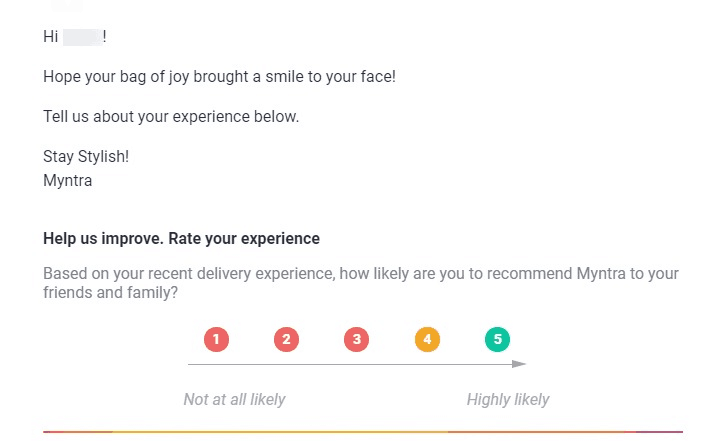Customers value experiences. A recent report from PWC reveals that 86% of customers are willing to pay more for a brand that offers a great customer experience. Yet another study found that customer experience will overtake price and product as the key brand differentiator. No wonder delivering the best experience has become the topmost priority for ecommerce stores.
A great customer experience (CX) can profoundly influence your audience’s purchase behavior, improve brand reputation, and give you an edge over your competitors. More than 50% of businesses worldwide have redirected their investments to CX, and more brands are appreciating the importance of customer experience as a customer retention strategy.
But delivering the best experience in today’s competitive market is a tricky undertaking. You may already be investing resources, but unless you measure your efforts, you will never know what satisfies or dissatisfies your customers.
How do you measure a qualitative concept like customer experience? Read on to get valuable insights on the key metrics you should be tracking to turn mere customers into passionate brand advocates.
Customer Satisfaction (CSAT)
CSAT is the average satisfaction score awarded by customers to a business after they have experienced its product or service. It’s measured by sending customers a survey.
Here’s how Myntra, a fashion ecommerce firm, determines whether or not their customers have had satisfying experiences.
CSAT not only helps you identify happy customers, but also detects negative experiences. That way, you have time to take corrective measures and control the damage before it blows out of proportion. Say a customer is unhappy with the slow checkout process or a long registration form. They will naturally offer a poor CSAT score. Such poor scores are an indicator of some problem in the system, enabling ecommerce stores to take the necessary action.
% of satisfied customers = x 100
As per the benchmarks shared by the American Customer Satisfaction Index (ASCI), the overall CSAT standard for the ecommerce industry is 80%. So, if your CSAT is close to or more than this score, you are doing a great job.
The health of your online business depends on how satisfied your customers are. Therefore, it’s advisable to check their satisfaction levels at regular touchpoints to get an accurate response. You can use CSAT surveys to gather insights:
- After the completion of an online transaction or the checkout process
- During the customer onboarding process
- After a customer support call or a live chat
- Following an event
- A week after the purchase
Net Promoter Score (NPS)
Net promoter score is simply the percentage of customers who would or wouldn’t recommend your brand to their circle. It can be also determined using a simple survey: “How likely are you to recommend us to your friends or family?” Customers rate the brand on a scale of 1 to 10 and NPS is calculated as shown in this image.
NPS gives you a fair idea of how happy or unhappy your customers are. Here is a definition of the three criteria for Net Promoter scores:
Knowing whether your customers are promoters, passives, or detractors can help you determine the next strategic step. For instance, if the customer is a promoter:
- Ask them to leave a review on your website or social media site
- Expose them to other products or upsell
- Encourage them to share your content on their page or contribute
Passives and detractors need extra attention too. Remember to follow up on their feedback, identify their concerns, and take the necessary action.
However, you need to carefully choose at which stage of the customer journey you want to use this metric. For instance, if a customer has called for the status of a delivery, your customer service team shouldn’t end the call by asking whether they will recommend your brand to others. In this case, it would be appropriate to wait for nearly a week after the customer has received the product and used it.
Ecommerce stores like Amazon and Myntra usually send the NPS survey email after the customer has had time to experience the product.
Wondering what’s the ideal NPS score? In the ecommerce world, even a single instance of poor experience is enough to convert a promoter into a detractor. Therefore, you should track each and every customer interaction to ensure an NPS score of more than 63, which is the industry average.
Customer Lifetime Value (CLV)
CLV is the total revenue your firm will earn from a customer during their relationship with the brand. Though CLV is not a new metric, it’s being increasingly used by businesses as a litmus to gauge their CX health, as it reflects how much a customer is enjoying a product or service. After all, the better the experience offered, the more loyal they are to a brand, thereby increasing their worth to the business (CLV).
This metric is different from NPS and CSAT, as it is tangibly linked to business revenue instead of loyalty and customer satisfaction, which are fairly intangible in nature. CLV is a great metric to measure customer experience if you have a long and continuing relationship with a customer, like a subscription to a nutrition or wellness product or a magazine. In such cases, an increasing CLV would indicate that the customer is enjoying the experience and satisfied with the product and services. On the other hand, a tanking CLV helps spot early signs of attrition which could be related to poor customer experience.
Monitoring this metric will also help you determine whether or not your customer experience efforts are working, and increase or decrease them in response.
Customer Effort Score (CES)
Great customer service is the foundation of building long-term relationships with customers. A delightful customer experience boosts loyalty, encouraging customers to repurchase and become your brand advocates. That’s why it’s important to measure CES, a metric that outlines the amount of effort a customer makes to interact with your product or service.
CES helps you determine whether your customers faced any difficulty completing certain actions while using your product or service. A simple survey can be deployed at specific customer touchpoints, like after the completion of a purchase transaction or interaction with a customer service representative.
For instance, after a customer interacts with your customer service team, you could ask them how easy it was to get their issue resolved. You could use a survey like the one shown below.
In this case, you can calculate CES by adding the total number of respondents who voted 5 or higher and divide it by the total number of people who participated in this survey. So, if 60 out of a total of 100 survey respondents ticked 5 or above, then you can safely assume that 60% of your customers feel that your product or service is user-friendly and well designed.
CES helps improve your process of purchase by getting rid of the factors that adversely affect user experience. For instance, a long checkout process involving many questions can negatively affect your CES. You may want to take a closer look at the purchase process and get rid of the unnecessary steps in order to lower CES and boost customer loyalty and retention.
Ecommerce businesses should consider the following tips to improve their CES.
Reduce the Wait Time – Whether it’s the time taken for an app to load or to get a query resolved, customers hate to wait. They want their query resolved quickly. They want apps and websites to load quickly.
Simplify the Checkout Process – As mentioned earlier, a long checkout process can irk customers, forcing them to either abandon the cart or give a poor rating in the CES survey. Improve your website experience with an optimized checkout process. Allowing guest checkout like Sears can help quicken the checkout process, thereby improving your site’s CX.
Don’t Forget to Optimize for Mobile – In this digital world, no one has patience for clumsy mobile sites and apps. Optimize your website for an awesome mobile experience.
Offer Multiple Contact Options – Make it easy for customers to get in touch with you by sharing multiple contact options like social media support, chat, email, and call centers.
Offer Self-Service Options – Self-service tools are no longer a nice-to-have feature. Customers expect brands to share FAQs, chatbots, a reorder button in the purchase history, real-time information on the order status, managing returns, and many such features that help them independently resolve the issues they are facing.
Conversion Rate
The entire ecommerce industry is working toward boosting their customer conversions. In fact, improving the conversion rate is the ultimate objective of any business. Yet, the global average conversion rate of the ecommerce segment remains under 3%.
The conversion rate of your business is directly affected by the quality of the customer experience you offer. Poor CX not only reduces the conversion rate but also is a major reason for increased cart abandonment rate. Customers often do not complete the purchase process because of fewer payment options, lack of clarity, lengthy or complex checkout processes, and high shipping costs. Tracking customer conversion and cart abandonment rates can help you identify the problems in the customer journey, allowing you to take corrective measures.
For instance, a poor checkout process is one of the top reasons why customers drop out before completing the purchase. If that’s the case, you should consider optimizing your checkout page in order to boost your site’s conversion rates.
The conversion rate is essentially the total number of completed transactions, divided by the total number of interactions. Use web analytics tools like Google Analytics, Clicky, FoxMetrics, and KISSmetrics to monitor your conversion rate with respect to your business goals.
The average ecommerce conversion rate is between 1-3%. So if your online store’s conversion is below this number, you definitely have a lot of work to do. Here are a few tips to improve your e-store’s conversion rate.
- Use a persuasive store design that keeps visitors on your page and helps them navigate with ease. Check out how IKEA makes it easy for its visitors to find products in each category, thereby improving the overall site experience.
Let customers shop on social media channels by making your Facebook and Instagram profiles shoppable.
- Use upselling and cross-selling strategies like Amazon.
- Personalize website and shopping experiences for customers based on their gender, location, lifestyle, and other factors. Check out how Stitch Fix, an online personal styling service aces at this.
- A/B split testing is one of the most effective methods to boost a website’s conversion rate. Use tools like Optimizely to A/B test your product offers, images and CTA buttons on your landing page, checkout process, and email headlines.
- Don’t overuse CTAs. Too many CTA buttons on one page can overwhelm your visitors, discouraging them from making a decision in your favor.
- Offer multiple payment options. Check out how Best Buy offers tons of payment options for its customers.
Customer Churn Rate
Poor experiences like poor product quality, non-personal customer service, misleading promotion, or repeated follow-ups can accumulate over a period of time, eroding the customer’s trust in the brand. Such customers are often primed to churn, especially when they come across a competitor’s brand offering better value and service.
Customer churn rate helps you determine the percentage of customers who are no longer using your product or service during a specific time frame. These are the customers who either haven’t made a repeat purchase or canceled a recurring service.
Let’s say you started off with a customer base of 1,000 and have 800 customers at the end of the month. Your churn rate can be calculated like this:
(1000-800)/1000 * 100 = 20%
In other words, you lost 20% of your customers.
Though every business loses customers, you should watch out for a high churn rate as it indicates your customers’ responses to new pricing, products, competitors, and policies. In an ideal scenario, a business’s churn rate should be zero. But that’s not possible! Regardless of how hard you try, you will lose customers.
So according to Baremetrics, a SaaS analytics platform, a “good” churn rate for SaaS companies should be between 3-5%. If your firm’s churn rate is higher than this figure you should do something about it!
Identify and Fix the Issue Causing Them to Leave – Call the customer, send a personalized email, or conduct a survey to determine the reason for the high churn rate. Identify the most common reasons they are abandoning you and work toward making things better for them. For instance, if your survey shows that people are abandoning the cart because of a complex checkout process, you need to fix the issue right away.
Offer Stellar Customer Service – Any small, bitter customer experience can cause you to lose that customer and increase your churn rate. Turn the frustrating experience into a pleasant one by offering 24/7 client support or an online chat tool to resolve the issue and retain your customer. This will also strengthen brand loyalty, which plays a key role in improving customer retention.
Keep Your Customers Engaged – Have an effective marketing strategy in place to bring customers back to your store. For instance, using marketing automation in your email marketing strategy you can send welcome emails, onboarding emails, and reactivation campaigns to your customers, encouraging them to visit your store and stay with you.
Acquiring new customers is a far more expensive undertaking than retaining existing ones. Use this metric to understand why the customer has stopped using your service and adopt a holistic churn prevention strategy to retain and grow your customer base.
Digital Experience Score (DXS)
Recently, Decibel, a CX firm, introduced an all-encompassing metric for measuring ecommerce customer experience on websites, web applications, and native apps. DXS uses its machine-learning algorithm to determine the quality of the digital experience provided to a customer. The metric takes into consideration how the customer moves around a website or app and their online behavior to determine the overall quality of digital experience.
This chart shows the way in which Decibel’s Digital Experience Intelligence Platform tracks each customer experience through clicks, mouse movements, scrolling, and other actions. This behavior data moves to the upper levels to determine the visitor’s state of mind. Thus, using this data, Decibel’s behavior detection algorithms automatically alert teams to specific user actions that indicate the visitor’s state of mind, whether they are frustrated, engaged, or confused.
Here is a screenshot of Decibel’s platform. The algorithm uses five distinctive areas, namely navigation, frustration, engagement, technical, and forms to arrive at a score between 1 and 10. This number quantifies the overall quality of CX a website is offering—10 being the highest experience score.
Using this platform you can measure your DXS and create unique customer experiences by working on the five pillars of digital experience mentioned above.
Navigation Score – This refers to the ease with which customers can move around your website and find the required information. Weird and confusing layouts are an absolute no! Make it easy and enjoyable.
Frustration Score – When a user clicks around or erratically scrolls through a page, it’s an indication of an error on your site that’s preventing them from taking the necessary action. Say the customer is shopping for a skirt and has added it to the cart. But the “Buy Now” button is unresponsive. This may cause the user to click the button multiple times, exhibiting their annoyance.
Engagement Score – This score tells you how much the user is enjoying your website. For instance, if users are spending more time on a page or scrolling through the content, you know they are captivated by the pages. Applying a persuasive design and offering awesome content can help improve this score.
Technical Score – This score is a reflection of the technical errors on your website. Errors like slow page loading or errors in code can adversely affect your site’s CX. Check for such errors and rectify them on a regular basis.
Form Score – This score rates each form on your site. So if a form that collects customer information isn’t functioning properly, this score is bound to suffer, thereby affecting your overall DXS score. Make sure all the forms on your website enable users to submit their information, queries, and comments with ease.
Over to You!
Customers prefer brands that offer unique experiences. In fact, they don’t mind paying a premium to experience something out of this world. No wonder the ecommerce world is buzzing with innovative customer experiences.
However, besides putting an awesome customer experience program in place, it’s paramount to measure your progress. What gets measured gets done! Use the CX metrics shared in this post to update your customer experience scorecard. This simple exercise will offer you interesting insights about your efforts, empowering you to create effective engagement strategies that convert.
Am I missing something here? If you are tracking any specific CX metrics, share them with us in the comments below!































